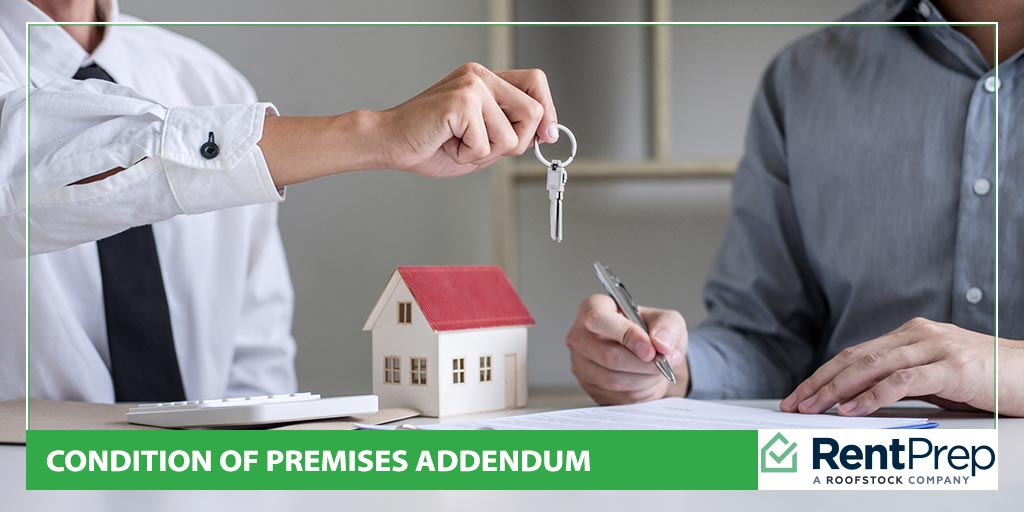
There are a lot of things to keep track of when you finish choosing a tenant and they’re getting ready to move into the property. Among other things, you need to be sure that you do a thorough check of the property with the tenant when they are moving in to ensure that you are both familiar with the property’s condition.
Some states, such as California, have specific cases when a condition of premises addendum must be added to the lease agreement. This addendum functions much like a move-in checklist, but the specifics inside the document may differ slightly.
Today, we’ll share our complete condition addendum template. This document can be used as a California lease addendum for the condition of premises, but that’s not the only time or place when you should consider using it.
A Table Of Contents For Premise Condition Addendums
- What Is A Condition Of Premises Addendum?
- Why Does The Condition Matter?
- How Does This Addendum Differ From A Move-In Checklist?
- Where To Use This Addendum: Three Examples
- Sample Condition Of Premises Documentation
- Be Flexible, But Be Thorough!
What Is A Condition Of Premises Addendum?
A condition of premises addendum is a specific type of lease addendum that is used to modify and clarify the terms of a rental or lease agreement. This addendum is used to ensure that both the tenant and the landlord are on the same page about the state of the property before the tenant moves in.
The document details each area of the property and the condition that it is in. If there is anything of note that needs to be clarified, there is a remarks section of the addendum to ensure that everything that should be known about the property is clearly documented and agreed upon by both parties.
Why Does The Condition Matter?
 If you’re still relatively new to the real estate world, you might be confused about why such a detailed list is necessary. If the property is in good condition, isn’t it enough to know just that?
If you’re still relatively new to the real estate world, you might be confused about why such a detailed list is necessary. If the property is in good condition, isn’t it enough to know just that?
Unfortunately, it is not. While landlords always hope to avoid needing to charge tenants for damages to the property, there are situations where some damage occurs at the property. When this happens, the landlord and tenant will both need to gather proof to determine who is responsible for the repair cost.
In some cases, it may even be necessary to go to court to settle the problem and find out who will be held liable for damages.
Using a document like the condition of premises addendum helps to ensure that neither party can lie or exaggerate about what the property was like before the tenant moved in. Once both parties sign off on the property’s condition, it will be very difficult to prove otherwise.
How Does This Addendum Differ From A Move-In Checklist?
In a lot of ways, this type of addendum and a move-in checklist are the same! The biggest difference is their name, but the actual information included in both documents can differ, too. However, there is no singular answer to what separates the two.
Why is that?
Simply put, it is because both documents are flexible. They can be modified to fit your specific situation or the local laws in your area. A condition of premises addendum is officially filed as part of the lease document because it is an addendum while a move-in checklist tends to be a standalone document used by the landlord and rental management system.
The information gathered by both documents, however, is the same. Filling out both would be redundant, so it is better to put your time into the document that works best for your business or for the one that is required by local laws.
Where To Use This Addendum: Three Examples
It’s hard to know when it is appropriate to put this type of document into action. Today, we’ll share three examples of when you should pull it out.
California: HUD Agreements
Landlords in California know that the California condition of premises addendum is sometimes required, always recommended. In particular, landlords that want to rent to HUD tenants or be involved in the HUD system in that region must use this document.
The California lease addendum condition of premises serves to ensure that the property has as few miscommunications as possible, and that is particularly important when working with a program like HUD that already involves a lot of red tape and bureaucracy.
Beyond HUD properties, the state of California makes it clear that is the duty of both the tenant and the landlord to agree on the property’s condition before move-in occurs. As such, this document is frequently used to document this agreement.
Michigan
California is not the only state that pushes for this type of clear and complete communication between both parties. Michigan law requires that an inventory checklist of all property and the condition of that property must be signed by both the tenant and the landlord within seven days of the tenant taking possession of the property.
Montana
Montana also has a law about checking the property’s condition. This law requires that the landlord gives the tenant a condition of premises statement at the start of their tenancy. The law clarifies what must be shared and how that information will be used if necessary. If the landlord fails to follow through as necessary, they could end up owing the tenant money.
Sample Condition Of Premises Documentation
 States like Montana, Michigan, and California have laws about furnishing a condition of premises document to tenants, but there are other states like Hawaii and Arizona that have similar requirements as well.
States like Montana, Michigan, and California have laws about furnishing a condition of premises document to tenants, but there are other states like Hawaii and Arizona that have similar requirements as well.
Even if the state that you work in does not have a law that requires you to use such an addendum, learning how to use one can benefit your business and protect you from costly miscommunications in the future.
Our sample template can help you learn to keep better track of your properties condition from the move-in day onwards:
| Condition of Premises Addendum |
Let’s break down this document so that you can get a full picture of what type of information should be collected to ensure the protection of your property.
Identifying Information
We like to begin all of our templates with the same basic identifying information:
- Date
- Property address
- Rental type
- Type of agreement
- Landlord name
- Tenant name
Including the basics of the property that are relevant to the document being signed is essential. Even though all parties involved know what property they are talking about, the document needs to be able to speak for itself. By clarifying as much information as possible, you can ensure that there is no confusion.
If a judge were to pick up this document without you present, they should be able to discern what property, landlord, tenant, and rental agreement is being modified by the signed document. If this information is not immediately obvious, you might have some problems if you ever need to go to court for eviction or other rental problems.
Agreement
The next section is the section that will be signed to agree to the document’s purpose. In this agreement section, explain what the document will do and how it will work.
In our template, the tenant and landlord will both sign off on this agreement section. By signing, they agree to jointly inspect all areas and agree to their condition. They also agree to note any problems under “Remarks.”
Condition of Premises
The next section is the longest part of the document. In the condition section, every part of the property will be listed with two blank columns next to it. One column is for a simple check mark to confirm that it has been checked. The remarks column is where any oddities or problems should be listed.
All parts of the following areas should be covered:
- Interior surfaces and rooms
- Plumbing
- Exterior areas
- Bathrooms
- Kitchen
- Electrical
- Entry area
- Common areas
Depending on your property’s layout and function, you may need to have more or less information in this section than is listed on our template document. Be sure to adjust your own document to perfectly reflect what is found at the premises. Otherwise, the document cannot be as useful as it is meant to be.
Signatures
The final section of the document is where you and the tenant should both sign off on the conditions listed above. By signing, you are both agreeing that everything listed on the document is accurate and agreed upon. To ensure that neither party can make any changes, each party will receive a copy of the document.
Be Flexible, But Be Thorough!
As mentioned, the condition of premises addendum is a relatively flexible document. It can be rewritten and presented in different ways as long as the information gathered is deep and detailed. The main priority is to record the condition of the property before move-in and show that both parties agree on that record.
As long as your document does that, it should be sufficient. The only thing that you really need to be extra careful about is whether or not your state and local government have specific requirements about what must be included in the document or when it needs to be given to tenants. Once you’ve made sure that you are following those rules, you’re in the clear!

